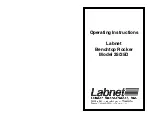
www.victorruoshui.co.kr
이 자료는 저작권법에 따라 보호받는 저작물이므로 무단배포 및 무단복제를 금하며, 내용을 이용하려면, 한국 VictorRuoshui 社
의 서면동의를 받아야 합니다.
0000.0
C(other graduation).
8.
Press
〔℃
/
℉〕
key , select Centigrade or Fahrenheit
unit.
(3) Resistance or thermal resistance(RTD)simulate
output
Note
·
Resistance simulate
:
The meter generates a simulate
resistance value ranging from 400
to 4000
from the output terminal (RTD/
). The output
method for simulate resistance is that the
meter outputs corresponding voltage “Vx
“according to incentive current “Ix” generated
by the calibrated meter, and for the R(set
resistance)
equals
to
Vx(output
voltage)/lx(incentive
current),
thus
the
calibrated body should supply a simulate
current to this meter. For realizing the
correct simulate output of 400
Ω
, the incentive
current should be within
±
0.5
~±
3mA range;
for simulate output of 4000
Ω
, the incentive
current should be within
±
0.05
~±
0.3mA
range;
Note
·
Resistance simulate
:
when the output resistance is
4-wired for calibration, the error generated by
the resistance (approximately 0.1
) of test
lead should be considered if the Users employ
two wires connection method; The meter may
generate incorrect resistance value if the
capacity between the output terminals and the
measured meter is higher than 0.1 uf.
Figure 5-2
1.
Insert the testing probe into the jack of the meter‟s
output terminal (RTD/
), and connect the other end
with input terminal of the Users‟ meter, see Figure
5-2: (the dedicated testing probe supplied by the
meter can be connected as three-wired or
four-wired output as required by the Users)
2.
The LCD shows „OUTPUT‟, indicating the meter is
OUTPUT
4W
Ix
V
3W
































